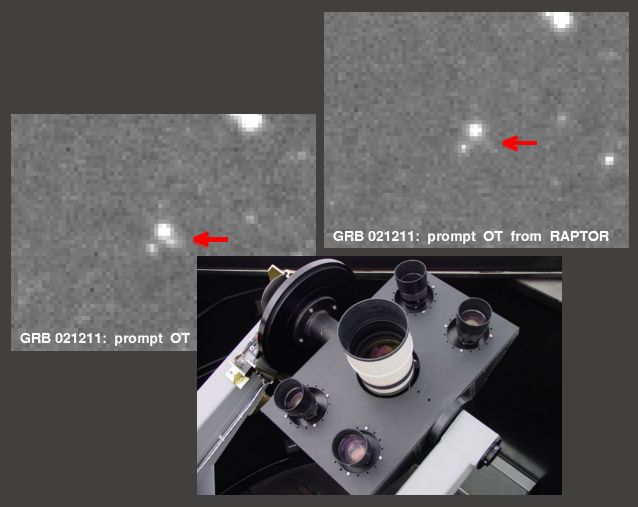Explanation: On December 11 astronomers found one of the brightest and most distant explosions in the Universe - a gamma-ray burst - hiding in the glare of a relatively nearby star. The earliest image of the burst's visible light was caught by an earthbound RAPTOR (RAPid Telescopes for Optical Response). The two exposures inset above were taken by a RAPTOR unit about 65 seconds (left) and 9 minutes (top right) after high-energy radiation from the burst, dutifully cataloged as GRB 021211, was identified by the orbiting HETE-2 satellite. One of only two optical transients (OTs) ever found at times so close to a burst's gamma-ray emission, the fading visible light source is indicated by arrows, blended with the image of foreground stars toward the constellation Canis Minor. The RAPTOR unit (lower inset) is designed with peripheral low resolution cameras and a central, sensitive high resolution imager, in analogy with a predator's vision. In the future, the RAPTOR project expects its innovative instruments to be able to independently discover and catalog a host of cosmic things that go bump in the night.
1999 2000 2001 2002 2003 2004 2005 2006 2007 2008 2009 2010 2011 2012 2013 2014 2015 2016 2017 2018 2019 2020 2021 2022 2023 2024 2025 |
Yanvar' Fevral' Mart Aprel' Mai Iyun' Iyul' Avgust Sentyabr' Oktyabr' Noyabr' Dekabr' |
NASA Web Site Statements, Warnings, and Disclaimers
NASA Official: Jay Norris. Specific rights apply.
A service of: LHEA at NASA / GSFC
& Michigan Tech. U.
|
Publikacii s klyuchevymi slovami:
gamma-ray burst - robotic telescope - optical transient - gamma-vspleski - Teleskopy opticheskie
Publikacii so slovami: gamma-ray burst - robotic telescope - optical transient - gamma-vspleski - Teleskopy opticheskie | |
Sm. takzhe:
Vse publikacii na tu zhe temu >> | |
